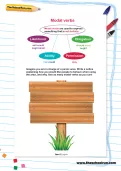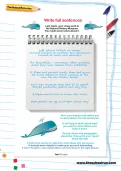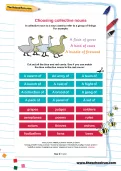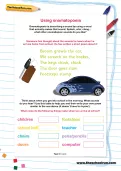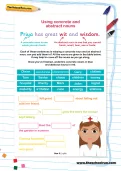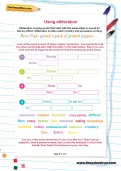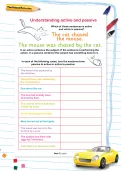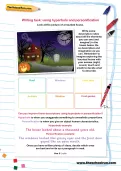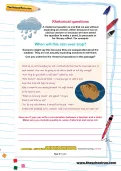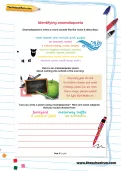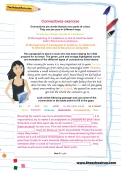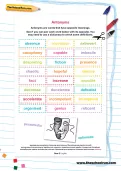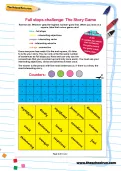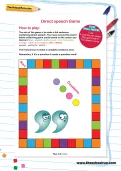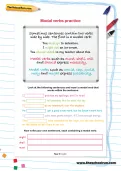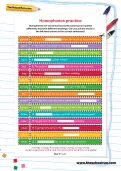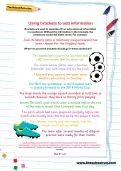Sometimes dashes are used in sentences to link different clauses and indicate a pause or break in the flow of a sentence. Look at these sentences and write in a dash where you think it should go in each one.
or
Register to add to your saved resources
Already a subscriber? to view this content.
Can you add the missing dashes into these sentences?
or
Register to add to your saved resources
Already a subscriber? to view this content.
Can you match up the collective nouns on the left with the correct nouns on the right?
or
Register to add to your saved resources
Already a subscriber? to view this content.
Onomatopoeia is describing a sound by using a word that actually makes that sound. Splash, whir, clang... what other onomatopeic sounds do you like? Think about when you get into school in the morning. What sounds do you hear? Use this table to help you and then write your own poem similar to the one above (it doesn’t have to rhyme!).
or
Register to add to your saved resources
Already a subscriber? to view this content.
Each of these sentences is missing a concrete noun and an abstract noun; can you add them in? Once you’ve finished, underline concrete nouns in blue and abstract nouns in red.
or
Register to add to your saved resources
Already a subscriber? to view this content.
Alliteration is using words that start with the same letter or sound for literary effect. Alliteration is often used in poetry and persuasive writing. Look at the name in each of these ‘empty’ sentences. You need to find all the other words that start with this letter in the table below. See if you can work out how to organise the words so that the sentences make sense.
or
Register to add to your saved resources
Already a subscriber? to view this content.
In each of the following cases, turn the sentence from passive to active or active to passive.
or
Register to add to your saved resources
Already a subscriber? to view this content.
These sentences contain a subject, verb and object. Underline the subject in green, the verb in purple and the object in orange.
or
Register to add to your saved resources
Already a subscriber? to view this content.
See if you can turn these active sentences into passive sentences.
or
Register to add to your saved resources
Already a subscriber? to view this content.
Look at this picture of a lake at night. Write some descriptive notes about all the elements you can see (and imagine!). Be as descriptive and imaginative as you can. Now can you turn any of these descriptions into similes or metaphors?
or
Register to add to your saved resources
Look at this picture of a haunted house. Write some descriptive notes about all the elements you can see (and imagine!). Be as descriptive and imaginative as you can. Remember to imagine exploring the
haunted house with your senses (sight, sound, touch and smell) to decide what to describe. Now, can you improve these descriptions using hyperbole or personification?
or
Register to add to your saved resources
Already a subscriber? to view this content.
A rhetorical question is one that we ask without expecting an answer, either because it has an obvious answer or because we have asked the question to make a point, to persuade or for literary effect. Now see if you can write a conversation between a teacher and a child. Make sure you include questions, some rhetorical and some not.
or
Register to add to your saved resources
Already a subscriber? to view this content.
Onomatopoeia is when a word sounds like the noise it describes. Can you write a poem using onomatopoeia? Here are some subjects that you could choose from.
or
Register to add to your saved resources
Already a subscriber? to view this content.
Connectives are words that join two parts of a text. Look at this passage and use some of the connectives in the table to fill in the gaps.
or
Register to add to your saved resources
Already a subscriber? to view this content.
Antonyms are words that have opposite meanings. See if you can pair each word below with its opposite. You may need to use a dictionary to check some definitions
or
Register to add to your saved resources
Already a subscriber? to view this content.
Each player collects parts of sentences as they go round the board then, when you get to the end, see who can write the best story using just the parts you've collected.
or
Register to add to your saved resources
Already a subscriber? to view this content.
The aim of the game is to make a full sentence containing direct speech. You move around the board collecting game cards based on the colour you land on. The first person to make a complete sentence wins.
or
Register to add to your saved resources
Already a subscriber? to view this content.
A fun Year 5 English worksheet made by a teacher to help primary-school children understand modal verbs. It includes examples and activities to make learning about modal verbs enjoyable and engaging.
or
Register to add to your saved resources
Already a subscriber? to view this content.
Homophones are words that sound the same but are spelled differently and have different meanings. Can you put the words in the left-hand column in the correct sentences?
or
Register to add to your saved resources
Already a subscriber? to view this content.
Brackets are used to separate off an extra piece of information in a sentence. Without the information in the brackets, the sentences would still make sense. Where do you think brackets should go in these sentences?
or
Register to add to your saved resources
